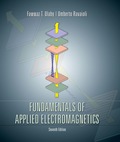
Concept explainers
The magnetic field of a wave propagating through a certain nonmagnetic material is given by
Find the following:
- (a) The direction of wave propagation.
- (b) The phase velocity.
- (c) The wavelength in the material.
- (d) The relative permittivity of the material.
- (e) The electric field phasor.
(a)
The direction of wave propagation for the given condition.
Answer to Problem 1P
The direction of wave propagation for the given condition is
Explanation of Solution
Given data:
The magnetic field intensity of the wave is
Calculation:
Write the standard expression for the magnetic field phasor of TEM wave propagating in the
Here,
In the above equation positive sign is used when the wave is travelling in the
In the given magnetic field negative sign is used so the direction of wave propagation is along the
Conclusion:
Therefore, the direction of wave propagation for the given condition is
(b)
The phase velocity for the given condition.
Answer to Problem 1P
The phase velocity for the given condition is
Explanation of Solution
Calculation:
Write the standard relation of phase velocity, wave number and angular frequency of uniform plane wave.
Here,
Compare the given magnetic field and equation (1) to calculate the value of
Substitute
Conclusion:
Therefore, the phase velocity for the given condition is
(c)
The wavelength in the material.
Answer to Problem 1P
The wavelength in the material is
Explanation of Solution
Calculation:
Write the standard relation between wavelength and wave number of plane wave.
Here,
Substitute
Conclusion:
Therefore, the wavelength in the material is
(d)
The relative permittivity of the medium.
Answer to Problem 1P
The relative permittivity
Explanation of Solution
Calculation:
Write the standard relation between relative permittivity and speed of light and phase velocity.
Here,
Substitute
Conclusion:
Therefore, the relative permittivity
(e)
The electric field phasor.
Answer to Problem 1P
The electric field phasor is
Explanation of Solution
Calculation:
Write the standard relation between electric field and magnetic field intensity.
Here,
Write the standard expression for the intrinsic impedance of the medium.
Here,
Write the standard expression for the electrical permittivity of any medium as,
Here,
Substitute
The permeability of the given non magnetic medium is,
Substitute
Substitute
Simplify the above expression.
The conversion from
So, the conversion from
Substitute
Conclusion:
Therefore, the electric field phasor is
Want to see more full solutions like this?
Chapter 7 Solutions
EBK FUNDAMENTALS OF APPLIED ELECTROMAGN
- 4-3) Similar to Lathi & Ding, Prob. P.4.2-3 For a DSB-SC signal g(t) = 2m(t)cos(4000) transmitting each of the following messages, (a) write an expression for G(f) and (b) sketch the magnitude spectrum |G(f)], specifying the FWHM (full width at half-maximum) of any spectrum peaks. a) m(t) = sinc²(100-50л) b) m(t)=400e-80,000r²arrow_forward4-2) Lathi & Ding, similar to problem 3.8-5. For the filter shown below, with an input signal whose PSD is given by S⭑(f) = П(0.25лf): (a) Find the total input power; (b) Find the transfer function H(f); (c) Find the power spectral density (PSD) of the output signal; (d) Find the total output power of the signal 500 ΚΩ d 1 µF dt y(t)arrow_forward4-1) Distortionless transmission A bandpass signal g(t) of bandwidth B = 2000 Hz centered at f= 5.0x104 Hz is passed through the RC filter below with RC = 4.0x105 radians/s. If over the passband, a variation of less than 2% in both amplitude response and time delay is considered to be distortionless transmission, would g(t) be transmitted without distortion? Find the approximate magnitude response and the approximate time delay for the signal. R w g(1) y(t)arrow_forward
- Fundamentals Of Energy Systems THQ1 Q6arrow_forwardA single phase has two group A and B, 50 Hz, overhead line system has radius of conductor 0.5 cm. alculate the total inductance of the line. a2 a1 6 cm 2 m 3m b₂ m B b₁arrow_forwardA single phase has two group of conductors A & B; where A consists of 3- sub conductors (a, b, c) each of its have a radius of 0.25 cm, and the group B consists of two sub conductors (d, e) each of its have a radius of 0.5 cm. Calculate the inductance of the total system where the distance between the sub conductors is as below. 9m 6m 6m ୦୩ Group A Group Barrow_forward
 Introductory Circuit Analysis (13th Edition)Electrical EngineeringISBN:9780133923605Author:Robert L. BoylestadPublisher:PEARSON
Introductory Circuit Analysis (13th Edition)Electrical EngineeringISBN:9780133923605Author:Robert L. BoylestadPublisher:PEARSON Delmar's Standard Textbook Of ElectricityElectrical EngineeringISBN:9781337900348Author:Stephen L. HermanPublisher:Cengage Learning
Delmar's Standard Textbook Of ElectricityElectrical EngineeringISBN:9781337900348Author:Stephen L. HermanPublisher:Cengage Learning Programmable Logic ControllersElectrical EngineeringISBN:9780073373843Author:Frank D. PetruzellaPublisher:McGraw-Hill Education
Programmable Logic ControllersElectrical EngineeringISBN:9780073373843Author:Frank D. PetruzellaPublisher:McGraw-Hill Education Fundamentals of Electric CircuitsElectrical EngineeringISBN:9780078028229Author:Charles K Alexander, Matthew SadikuPublisher:McGraw-Hill Education
Fundamentals of Electric CircuitsElectrical EngineeringISBN:9780078028229Author:Charles K Alexander, Matthew SadikuPublisher:McGraw-Hill Education Electric Circuits. (11th Edition)Electrical EngineeringISBN:9780134746968Author:James W. Nilsson, Susan RiedelPublisher:PEARSON
Electric Circuits. (11th Edition)Electrical EngineeringISBN:9780134746968Author:James W. Nilsson, Susan RiedelPublisher:PEARSON Engineering ElectromagneticsElectrical EngineeringISBN:9780078028151Author:Hayt, William H. (william Hart), Jr, BUCK, John A.Publisher:Mcgraw-hill Education,
Engineering ElectromagneticsElectrical EngineeringISBN:9780078028151Author:Hayt, William H. (william Hart), Jr, BUCK, John A.Publisher:Mcgraw-hill Education,





